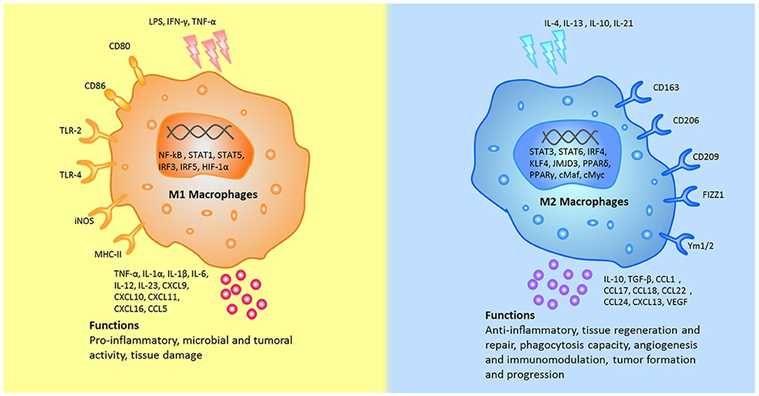Macrophage Markers
Related Symbol Search List
- CD40
- CD80
- CD74
- IL-10
- ITGAX
- CD16a
- FCGR3B
- CD45
- CD147
- ITGA4
- LTBR
- LTB4R
- SPN
- CLEC4A
- CD32A
- Fcgr2b
- MS4A2
- Latexin
- CD68
- LILRA5
- TREM1
- TREML2
- ENG
- CD31
- Iba1
- CCL1
- CCL15
- CCL17
- CCL18
- CCL20
- CD163
- Cd209b
- CD274
- CD300A
- CD300C
- CD300E
- CD300LB
- CD300LF
- CD302
- CD33
- CD36
- CD84
- CLEC10A
- Carboxypeptidase M
- Cxcl10
- CXCL11
- CXCL9
- GPNMB
- IGF1
- IL12RB1
- IL1RL2
- Il34
- ITGA2B/CD41
- Integrin beta 3
- LILRA3
- LILRB1
- ILT4
- LILRB3
- LRP1
- Ly86
- LY96
- MAEA
- MARCO
- NUP85
- PD-L2
- PPARG
- PVR
- LIMPII
- SLAMF7
- SLAMF8
- SLAMF9
- TLR3
- TLR4
- LIGHT
- TREM2
- TREML1
Immunology Background
About Macrophage Markers
Macrophages are important immune cells involved in various physiological and pathological processes. To identify and characterize macrophages, researchers utilize specific markers that are expressed on the surface of these cells. These markers help in distinguishing macrophages from other cell types and provide insights into their functions and activation states. Macrophage polarization is crucial for tissue repair and homeostasis maintenance (9). Macrophage polarization refers to the process by which macrophages produce distinct functional phenotypes as a reaction to specific microenvironmental stimuli and signals. Macrophages can be polarized into classically activated (M1) and alternatively activated (M2) macrophages. M2 macrophages are divided into M2a, M2b, M2c, and M2d subcategories. These macrophages differ in their cell surface markers, secreted cytokines, and biological functions.
 Fig. 1 The different stumili, surface markers, secreted cytokines, and biological functions between M1 and M2 macrophages were summarized. (Yao Y, et al., 2019)
Fig. 1 The different stumili, surface markers, secreted cytokines, and biological functions between M1 and M2 macrophages were summarized. (Yao Y, et al., 2019)
Here is an introduction to some commonly used macrophage markers:
CD68: CD68 is a heavily glycosylated transmembrane protein and a widely used marker for macrophages. It is primarily expressed in the lysosomes and cytoplasmic granules of macrophages. CD68 is involved in various macrophage functions, including phagocytosis and antigen presentation.
CD14: CD14 is a co-receptor for lipopolysaccharide (LPS) and is expressed on the surface of monocytes, macrophages, and some dendritic cells. It plays a crucial role in recognizing and binding bacterial LPS, triggering inflammatory responses. CD14 is commonly used as a marker to identify monocyte-derived macrophages.
CD11b: CD11b, also known as integrin alpha M, is a component of the Mac-1 integrin complex. It is expressed on the surface of monocytes, macrophages, and other myeloid cells. CD11b is involved in cell adhesion, migration, and phagocytosis. It is often used in combination with other markers to identify macrophages.
F4/80: F4/80 is a cell surface antigen expressed predominantly on mature macrophages in various tissues, including the liver, spleen, and adipose tissue. It is commonly used as a marker for tissue-resident macrophages.
CD206 (Mannose Receptor): CD206 is a C-type lectin receptor expressed on macrophages, particularly on those with an anti-inflammatory or tissue repair phenotype. It plays a role in the recognition and uptake of glycoproteins and pathogens. CD206 is often used as a marker for M2 or activated macrophages.
CD11c: CD11c is a transmembrane glycoprotein expressed on the surface of dendritic cells, monocytes, and some tissue macrophages. It is commonly used in combination with other markers to identify macrophages in specific tissues or under certain conditions.
MerTK: MerTK (Mer Tyrosine Kinase) is a receptor tyrosine kinase expressed on macrophages involved in phagocytosis and clearance of apoptotic cells. It is often used as a marker for resident tissue macrophages and specialized macrophage subsets, such as microglia in the brain.
These are just a few examples of macrophage markers commonly used in research. It's important to note that the expression of these markers can vary depending on the tissue, activation state, and microenvironment. By utilizing these markers, researchers can identify, characterize, and study macrophages in different contexts, advancing our understanding of their roles in immunity, inflammation, tissue homeostasis, and disease.
Physiological Functions of Macrophage Markers
Macrophage markers are proteins or molecules expressed on the surface of macrophages, and they play important roles in various physiological functions of these immune cells. Here are some physiological functions associated with macrophage markers:
Phagocytosis and Clearance: Macrophage markers such as CD68, CD11b, and F4/80 are involved in the recognition, engulfment, and clearance of foreign pathogens, apoptotic cells, cellular debris, and other particles. These markers help macrophages efficiently perform their role as scavengers and participate in tissue remodeling and repair processes.
Inflammatory Responses: Macrophage markers like CD14 and CD11c are associated with the activation of macrophages in response to inflammatory stimuli. They contribute to the initiation and amplification of inflammatory responses by recognizing pathogen-associated molecular patterns (PAMPs) and danger-associated molecular patterns (DAMPs).
Antigen Presentation: Macrophages are professional antigen-presenting cells (APCs) that play a crucial role in initiating and regulating adaptive immune responses. Markers such as CD14, CD11b, and CD11c are involved in antigen presentation by macrophages, facilitating the activation of T cells and the generation of specific immune responses.
Tissue Homeostasis: Macrophages contribute to tissue homeostasis by removing dying or damaged cells and promoting tissue repair and regeneration. Macrophage markers like CD68, F4/80, and MerTK are associated with tissue-resident macrophages involved in maintaining tissue integrity, remodeling, and resolving inflammation.
Modulation of Immune Responses: Macrophages can adopt different functional phenotypes depending on the microenvironment. Macrophage markers such as CD206 (Mannose Receptor) are associated with an anti-inflammatory or tissue repair phenotype (M2 macrophages). These markers help identify macrophages involved in immune regulation, tissue remodeling, and suppression of excessive inflammation.
Phagocytosis of Microorganisms: Macrophage markers, such as CD14 and CD11b, are involved in the recognition and phagocytosis of microbial pathogens. They facilitate the efficient engulfment of bacteria, fungi, parasites, and other pathogens, leading to their destruction and clearance.
Wound Healing: Macrophages play a crucial role in the various stages of wound healing. Macrophage markers, including CD68, F4/80, and CD206, are associated with macrophages involved in initiating the inflammatory response, promoting angiogenesis, and facilitating tissue remodeling during wound repair.
Understanding the physiological functions of macrophage markers is essential for studying their roles in immune responses, tissue homeostasis, and disease processes. These markers provide valuable tools for identifying, characterizing, and manipulating macrophages in research and clinical settings, ultimately leading to a better understanding of macrophage biology and the development of targeted therapies.

Available Resources for Macrophage Markers
At Creative BioMart, we are dedicated to supporting scientific researchers with a diverse range of products and customized services focused on macrophage markers. Our product line includes recombinant proteins and more. We have diligently curated an extensive assortment of resources on macrophage markers, encompassing associated pathways, protein functions, interacting proteins, relevant articles, research domains, and related topics. Whether you are in search of a deeper understanding of the regulatory mechanisms and pathways of macrophage markers or aiming to comprehend their roles and functions in various biological processes, we are fully equipped to address your requirements.
Our Featured Products
- Recombinant Human CD68, Fc-His tagged
- Recombinant Mouse Cd68 protein, His-tagged
- Active Recombinant Human CD80, His-tagged, Biotinylated
- Active Recombinant Human CD80 protein, His-tagged
- Recombinant Human CD80, GST-tagged
- Recombinant Human CD80 Protein, Fc/His-tagged, Alexa Fluor 488 conjugated
- Recombinant Human CD80 Protein, His-tagged, Alexa Fluor 555 conjugated
Should you have any questions, specific requirements, or intentions for collaboration, please don't hesitate to reach out to us. We eagerly anticipate the opportunity to collaborate with you and assist in achieving your research and commercial goals.
References:
- Yao Y, Xu XH, Jin L. Macrophage Polarization in Physiological and Pathological Pregnancy[J].Frontiers in Immunology, 2019, 10. DOI:10.3389/fimmu.2019.00792.
- Chen, Zetao, Klein, et al. Osteoimmunomodulation for the development of advanced bone biomaterials[J].[2024-01-15].

